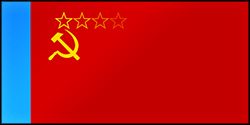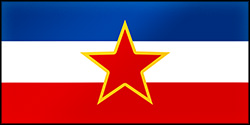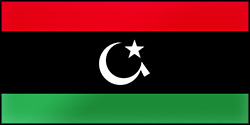
Soviet Russia
 After the Second Great War, the Eurasian continent slowly began to recover. The Soviet Union was disbanded, its army reduced to security forces, and the government overseen by Allied Forces for several years. As soon as the occupants left, however, the Russians began secretly rebuilding their army in industrial plants and technology complexes hidden deep in the Ural Mountains and Siberia.
After the Second Great War, the Eurasian continent slowly began to recover. The Soviet Union was disbanded, its army reduced to security forces, and the government overseen by Allied Forces for several years. As soon as the occupants left, however, the Russians began secretly rebuilding their army in industrial plants and technology complexes hidden deep in the Ural Mountains and Siberia.
Russian generals revised their military doctrine as well, focusing on a mass produced yet durable mobile force. They rely on cybernetics, high tech conventional weaponry such as thermobaric missiles and an airforce that can fight head to head with any Allied nation. The result of the ban on rebuilding their nuclear arsenal (which was circumvented partly through the counter-espionage of the elite PsiCorps division - Soviets' trump card) is the development of weaponised seismic technology, further boltstering their ability to wreak carnage upon their enemies.
NATIONAL FEATURES:

Yugoslavia
 Many were not pleased with the old monarchy in Yugoslavia, a country of many different nationalities and visions. After the war, with the tyrants toppled, a fresh democracy arose, but not without its own difficulties. With one party coming after another and nationalities fighting among themselves, the Serbian communists saw an opportunity. They organized a coup d'ètat and reunified Yugoslavia through force of willpower. Thanks to cooperation with Russia, the country grew in strength soon after.
Many were not pleased with the old monarchy in Yugoslavia, a country of many different nationalities and visions. After the war, with the tyrants toppled, a fresh democracy arose, but not without its own difficulties. With one party coming after another and nationalities fighting among themselves, the Serbian communists saw an opportunity. They organized a coup d'ètat and reunified Yugoslavia through force of willpower. Thanks to cooperation with Russia, the country grew in strength soon after.
Being aware that with Second Great War equipment they were easy prey, the Yugoslavian government put great emphasis on military research in its budget. Rejuvinating the as yet unrealised potential of Serbia's favourite son, Nikola Tesla, they were able to fulfill aspirations to arm themselves with his potent electrical and energy based weapons. The great leap in technology in many fields that followed even allowed Yugoslavia to construct civilian and military satellites, reaching orbit before their competitors in the ensuing space race.
NATIONAL FEATURES:

Libyan Republic
 Libya gained its independence from bankrupt Italy after the Second Great War but remained under heavy influence of the United States - who were mainly interested in North African oil fields. After years of exploitation, the people of the pseudo-colony had enough of the corruption and foreign control. The revolution, silently supported by Romanov's Russia, overthrew the sitting government and pushed US influence from their country.
Libya gained its independence from bankrupt Italy after the Second Great War but remained under heavy influence of the United States - who were mainly interested in North African oil fields. After years of exploitation, the people of the pseudo-colony had enough of the corruption and foreign control. The revolution, silently supported by Romanov's Russia, overthrew the sitting government and pushed US influence from their country.
The light of a people's revolution soon dimmed however as the newly empowered government sought rapid expansion of its domain over any regards for Human rights, overseeing the start of a slave labour campaign to rapidly mine the rich resources that awaited exploitation. What particularly caught Libyan military interest, however, was nuclear energy. They quickly bought plans for nuclear reactors from friendly Soviet Russia, in part due to their shared mistrust of the West. Nuclear waste proved to be an issue that couldn't be taken lightly though, therefore the Libyan army developed various nuclear-based munitions as a disposal method. Equipped with such deadly weapons, they are rightfully feared by those who previously opposed their independence.
NATIONAL FEATURES:

Confederation
 The Confederation may be the least developed member of the Comintern in terms of industrial capacity, but it remains a very important ally never-the-less. After years of political pressure and blackmailing from their North American neighbours, South American socialists signed the Confederation Pact, uniting their nations into an unbreakable alliance defying the desires of the Western imperialists for a chaotic, dependent Latin sphere.
The Confederation may be the least developed member of the Comintern in terms of industrial capacity, but it remains a very important ally never-the-less. After years of political pressure and blackmailing from their North American neighbours, South American socialists signed the Confederation Pact, uniting their nations into an unbreakable alliance defying the desires of the Western imperialists for a chaotic, dependent Latin sphere.
Due to limited military capability however, the Confederation primarily uses outdated conventional weaponry bought from their allies or seized from Western armed insurgents. The exception, however, is their helicopters, crafted by highly creative home grown engineers. This mobile airforce contributes greatly to the Confederation's resilience in suppressing often US ignited insurgencies and CIA driven terror campaigns. They rely on guerilla tactics and small independently operating groups to weaken their enemies so that their conscripted forces can finish them off.
NATIONAL FEATURES:

































































